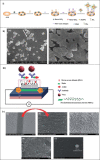Critical overview on the application of sensors and biosensors for clinical analysis
- PMID: 32287540
- PMCID: PMC7112812
- DOI: 10.1016/j.trac.2016.04.004
Critical overview on the application of sensors and biosensors for clinical analysis
Abstract
Sensors and biosensors have been increasingly used for clinical analysis due to their miniaturization and portability, allowing the construction of diagnostic devices for point-of-care testing. This paper presents an up-to-date overview and comparison of the analytical performance of sensors and biosensors recently used in clinical analysis. This includes cancer and cardiac biomarkers, hormones, biomolecules, neurotransmitters, bacteria, virus and cancer cells, along with related significant advances since 2011. Some methods of enhancing the analytical performance of sensors and biosensors through their figures of merit are also discussed.
Keywords: Analytical performance; Biosensor; Clinical analysis; Figure of merit; Sensor.
© 2016 Elsevier B.V. All rights reserved.
Figures






References
-
- Justino C.I.L., Rocha-Santos T.A.P., Duarte A.C. Advances in point-of-care technologies with biosensors based on carbon nanotubes. Trends Anal. Chem. 2013;45:24–36.
-
- Giri B., Pandey B., Neupane B., Ligler F.S. Signal amplification strategies for microfluidic immunoassays. Trends Anal. Chem. 2015;79:326–334.
-
- Justino C.I.L., Rocha-Santos T.A.P., Duarte A.C. Review of analytical figures of merit of sensors and biosensors in clinical applications. Trends Anal. Chem. 2010;29:1172–1183.
-
- Justino C.I.L., Duarte A.C., Rocha-Santos T.A.P. Immunosensors in clinical laboratory diagnostics. Adv. Clin. Chem. 2016;73:65–108. - PubMed
-
- Thévenot D.R., Toth K., Durst R.A., Wilson G.S. Electrochemical biosensors: recommended definitions and classification. Biosens. Bioelectron. 2001;16:121–131. - PubMed
Publication types
LinkOut - more resources
Full Text Sources
